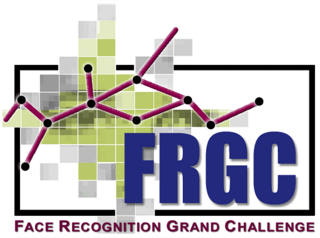Related Research Articles

Optical character recognition or optical character reader (OCR) is the electronic or mechanical conversion of images of typed, handwritten or printed text into machine-encoded text, whether from a scanned document, a photo of a document, a scene photo or from subtitle text superimposed on an image.
Affective computing is the study and development of systems and devices that can recognize, interpret, process, and simulate human affects. It is an interdisciplinary field spanning computer science, psychology, and cognitive science. While some core ideas in the field may be traced as far back as to early philosophical inquiries into emotion, the more modern branch of computer science originated with Rosalind Picard's 1995 paper on affective computing and her book Affective Computing published by MIT Press. One of the motivations for the research is the ability to give machines emotional intelligence, including to simulate empathy. The machine should interpret the emotional state of humans and adapt its behavior to them, giving an appropriate response to those emotions.

An eigenface is the name given to a set of eigenvectors when used in the computer vision problem of human face recognition. The approach of using eigenfaces for recognition was developed by Sirovich and Kirby and used by Matthew Turk and Alex Pentland in face classification. The eigenvectors are derived from the covariance matrix of the probability distribution over the high-dimensional vector space of face images. The eigenfaces themselves form a basis set of all images used to construct the covariance matrix. This produces dimension reduction by allowing the smaller set of basis images to represent the original training images. Classification can be achieved by comparing how faces are represented by the basis set.

A facial recognition system is a technology potentially capable of matching a human face from a digital image or a video frame against a database of faces. Such a system is typically employed to authenticate users through ID verification services, and works by pinpointing and measuring facial features from a given image.
Robert M. Haralick is Distinguished Professor in Computer Science at Graduate Center of the City University of New York (CUNY). Haralick is one of the leading figures in computer vision, pattern recognition, and image analysis. He is a Fellow of the Institute of Electrical and Electronics Engineers (IEEE) and a Fellow and past president of the International Association for Pattern Recognition. Professor Haralick is the King-Sun Fu Prize winner of 2016, "for contributions in image analysis, including remote sensing, texture analysis, mathematical morphology, consistent labeling, and system performance evaluation".

A standard test image is a digital image file used across different institutions to test image processing and image compression algorithms. By using the same standard test images, different labs are able to compare results, both visually and quantitatively.
Object recognition – technology in the field of computer vision for finding and identifying objects in an image or video sequence. Humans recognize a multitude of objects in images with little effort, despite the fact that the image of the objects may vary somewhat in different view points, in many different sizes and scales or even when they are translated or rotated. Objects can even be recognized when they are partially obstructed from view. This task is still a challenge for computer vision systems. Many approaches to the task have been implemented over multiple decades.
The Facial Recognition Technology (FERET) program was a government-sponsored project that aimed to create a large, automatic face-recognition system for intelligence, security, and law enforcement purposes. The program began in 1993 under the combined leadership of Dr. Harry Wechsler at George Mason University (GMU) and Dr. Jonathan Phillips at the Army Research Laboratory (ARL) in Adelphi, Maryland and resulted in the development of the Facial Recognition Technology (FERET) database. The goal of the FERET program was to advance the field of face recognition technology by establishing a common database of facial imagery for researchers to use and setting a performance baseline for face-recognition algorithms.

Multiple Biometric Grand Challenge (MBGC) is a biometric project. Its primary goal is to improve performance of face and iris recognition technology on both still and video imagery with a series of challenge problems and evaluation.

The Face Recognition Grand Challenge (FRGC) was conducted from May 2004 until March 2006 to promote and advance face recognition technology. It succeeded the Face Recognition Vendor Test.

The Face Recognition Vendor Test (FRVT) was a series of large scale independent evaluations for face recognition systems realized by the National Institute of Standards and Technology in 2000, 2002, 2006, 2010, 2013 and 2017. Previous evaluations in the series were the Face Recognition Technology (FERET) evaluations in 1994, 1995 and 1996. The project is now in an Ongoing status with periodic reports, and continues to grow in scope. It now includes tests for Face-in-Video-Evaluation (FIVE), facial morphing detection, and testing for demographic effects.
Local binary patterns (LBP) is a type of visual descriptor used for classification in computer vision. LBP is the particular case of the Texture Spectrum model proposed in 1990. LBP was first described in 1994. It has since been found to be a powerful feature for texture classification; it has further been determined that when LBP is combined with the Histogram of oriented gradients (HOG) descriptor, it improves the detection performance considerably on some datasets. A comparison of several improvements of the original LBP in the field of background subtraction was made in 2015 by Silva et al. A full survey of the different versions of LBP can be found in Bouwmans et al.
Matti Kalevi Pietikäinen is a computer scientist. He is currently Professor (emer.) in the Center for Machine Vision and Signal Analysis, University of Oulu, Finland. His research interests are in texture-based computer vision, face analysis, affective computing, biometrics, and vision-based perceptual interfaces. He was Director of the Center for Machine Vision Research, and Scientific Director of Infotech Oulu.

The MNIST database is a large database of handwritten digits that is commonly used for training various image processing systems. The database is also widely used for training and testing in the field of machine learning. It was created by "re-mixing" the samples from NIST's original datasets. The creators felt that since NIST's training dataset was taken from American Census Bureau employees, while the testing dataset was taken from American high school students, it was not well-suited for machine learning experiments. Furthermore, the black and white images from NIST were normalized to fit into a 28x28 pixel bounding box and anti-aliased, which introduced grayscale levels.
DeepFace is a deep learning facial recognition system created by a research group at Facebook. It identifies human faces in digital images. The program employs a nine-layer neural network with over 120 million connection weights and was trained on four million images uploaded by Facebook users. The Facebook Research team has stated that the DeepFace method reaches an accuracy of 97.35% ± 0.25% on Labeled Faces in the Wild (LFW) data set where human beings have 97.53%. This means that DeepFace is sometimes more successful than human beings. As a result of growing societal concerns Meta announced that it plans to shut down Facebook facial recognition system, deleting the face scan data of more than one billion users. This change will represent one of the largest shifts in facial recognition usage in the technology's history. Facebook planned to delete by December 2021 more than one billion facial recognition templates, which are digital scans of facial features. However, it did not plan to eliminate DeepFace which is the software that powers the facial recognition system. The company has also not ruled out incorporating facial recognition technology into future products, according to Meta spokesperson.
Emotion recognition is the process of identifying human emotion. People vary widely in their accuracy at recognizing the emotions of others. Use of technology to help people with emotion recognition is a relatively nascent research area. Generally, the technology works best if it uses multiple modalities in context. To date, the most work has been conducted on automating the recognition of facial expressions from video, spoken expressions from audio, written expressions from text, and physiology as measured by wearables.
Amazon Rekognition is a cloud-based software as a service (SaaS) computer vision platform that was launched in 2016. It has been sold to, and used by, a number of United States government agencies, including U.S. Immigration and Customs Enforcement (ICE) and Orlando, Florida police, as well as private entities.

Michael J. Black is an American-born computer scientist working in Tübingen, Germany. He is a founding director at the Max Planck Institute for Intelligent Systems where he leads the Perceiving Systems Department in research focused on computer vision, machine learning, and computer graphics. He is also an Honorary Professor at the University of Tübingen.
References
- ↑ Flanagan, Patricia (January 25, 2011). "Face Recognition Technology (FERET)". NIST. Retrieved 2018-07-11.
- ↑ Li, Stan; Jain, Anil, eds. (2011). Handbook of Face Recognition. Springer-Verlag London. pp. 310–312. ISBN 978-0-85729-931-4.
- ↑ P. J. Phillips, H. Moon, S. A. Rizvi, and P. J. Rauss (January 7, 1999). "The FERET Evaluation Methodology for Face-recognition Algorithms". NISTIR 6264 and IEEE Trans. Pattern Analysis and Machine Intelligence, 22(10), Oct. 2000.